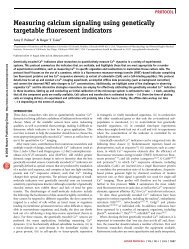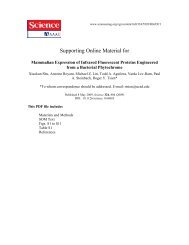THE GREEN FLUORESCENT PROTEIN - Tsien
THE GREEN FLUORESCENT PROTEIN - Tsien
THE GREEN FLUORESCENT PROTEIN - Tsien
You also want an ePaper? Increase the reach of your titles
YUMPU automatically turns print PDFs into web optimized ePapers that Google loves.
<strong>GREEN</strong> <strong>FLUORESCENT</strong> <strong>PROTEIN</strong> 515results support the sequential mechanism and provide the rate constants shownin Figure 2. However, many other aspects of the maturation mechanism remainobscure, such as the steric and catalytic roles of neighboring residues, themeans by which mutations can improve folding efficiency, and the dependenceof oxidation rate on the oxygen concentration and the protein sequence.One predicted consequence of oxidation by O 2 is that hydrogen peroxide,H 2 O 2 , is presumably released in 1:1 stoichiometry with mature GFP. Thisbyproduct might explain occasions when high-level expression of GFP canbe deleterious. Perhaps catalase could be useful in such cases. Some difficultGFPs seem to express most readily when targeted to peroxisomes and mitochondria(28; R Rizzuto, T Pozzan, personal communication). Is it a coincidencethat these organelles are the best at coping with reactive oxygen species?Crystal Structures; Tolerance of TruncationsAlthough GFP was first crystallized in 1974 (4) and diffraction patterns reportedin 1988 (29), the structure was first solved in 1996 independently byOrmö et al (30), Protein Data Bank accession number 1EMA, and by Yang et al(31), accession number 1GFL. Both groups relied primarily on multiple anomalousdispersion of selenomethionine groups to obtain phasing information fromrecombinant protein. Subsequent structures of other crystal forms and mutants(32–34a) have been solved by molecular replacement from the 1EMA coordinates.GFP is an 11-stranded β-barrel threaded by an α-helix running up theaxis of the cylinder (Figure 3). The chromophore is attached to the α-helix andis buried almost perfectly in the center of the cylinder, which has been called aβ-can (31, 34a). Almost all the primary sequence is used to build the β-barreland axial helix, so that there are no obvious places where one could design largedeletions and reduce the size of the protein by a significant fraction. Residues1 and 230–238 were too disordered to be resolved; these regions correspondclosely to the maximal known amino- and carboxyl-terminal deletions that stillpermit fluorescence to develop (35). A surprising number of polar groups andstructured water molecules are buried adjacent to the chromophore (Figure 4).Particularly important are Gln69, Arg96, His148, Thr203, Ser205, and Glu222.DimerizationThe excitation spectrum of wild-type GFP changes its shape as a function ofprotein concentration, implying some form of aggregation (8). The spectroscopiceffects of such aggregation are discussed in the section on “Absorbanceand Fluorescence Properties.” In the Yang et al structure for wild-type GFP(31), the GFP is dimeric. The dimer interface includes hydrophobic residuesAla206, Leu221, and Phe 223 as well as hydrophilic contacts involving Tyr39,Glu142, Asn 144, Ser147, Asn149, Tyr151, Arg168, Asn170, Glu172, Tyr200,






